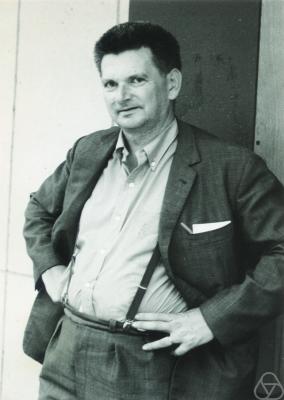<Back to Index>
- Mathematician René Frédéric Thom, 1923
- Writer Paul Charles Joseph Bourget, 1852
- 2nd President of Kenya Daniel Toroitich arap Moi, 1924
PAGE SPONSOR

René Frédéric Thom (September 2, 1923 – October 25, 2002) was a French mathematician. He made his reputation as a topologist, moving on to aspects of what would be called singularity theory; he became world famous among the wider academic community and the educated general public for one aspect of this latter interest, his work as founder of catastrophe theory (later developed by Erik Christopher Zeeman). He received the Fields Medal in 1958.
René Thom was born in Montbéliard, Doubs. He was educated at the Lycée Saint-Louis and the École Normale Supérieure, both in Paris. He received his PhD in 1951 from the University of Paris. His thesis, titled Espaces fibrés en sphères et carrés de Steenrod (Sphere bundles and Steenrod squares), was written under the direction of Henri Cartan. The foundations of cobordism theory, for which he received the Fields Medal at Edinburgh in 1958, were already present in his thesis.
After a fellowship in the United States, he went on to teach at the Universities of Grenoble (1953 – 1954) and Strasbourg (1954 – 1963), where he was appointed Professor in 1957. In 1964, he moved to the Institut des Hautes Études Scientifiques, in Bures - sur - Yvette. He was awarded the Grand Prix Scientifique de la Ville de Paris in 1974, and became a Member of the Academie des Sciences of Paris in 1976.
While René Thom is most known to the public for his development of catastrophe theory between 1968 and 1972, his earlier work was on differential topology. In the early 1950s it concerned what are now called Thom spaces, characteristic classes, cobordism theory, and the Thom transversality theorem. Another example of this line of work is the Thom conjecture, versions of which have been investigated using gauge theory. From the mid 50's he moved into singularity theory, of which catastrophe theory is just one aspect, and in a series of deep (and at the time obscure) papers between 1960 and 1969 developed the theory of stratified sets and stratified maps, proving a basic stratified isotopy theorem describing the local conical structure of Whitney stratified sets, now known as the Thom - Mather isotopy theorem. Much of his work on stratified sets was developed so as to understand the notion of topologically stable maps, and to eventually prove the result that the set of topologically stable mappings between two smooth manifolds is a dense set. Thom's lectures on the stability of differentiable mappings, given at Bonn in 1960, were written up by Harold Levine and published in the proceedings of a year long symposium on singularities at Liverpool University during 1969 - 70, edited by Terry Wall. The proof of the density of topologically stable mappings was completed by John Mather in 1970, based on the ideas developed by Thom in the previous ten years. A coherent detailed account was published in 1976 by C. Gibson, K. Wirthmuller, E. Looijenga and A. du Plessis.
During the last twenty years of his life Thom's published work was mainly in philosophy and epistemology, and he undertook a reevaluation of Aristotle's writings on science.
Beyond Thom's contributions in algebraic topology, his influence on modern differential geometry, through the intensive study of generic properties, can hardly be exaggerated.